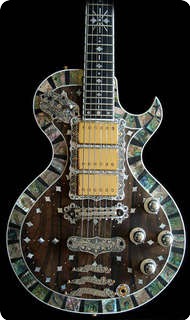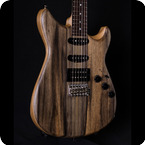Teye Guitars / El Doblón / Guitar
This is the only double-neck that Teye has so far made, and possibly the only one he will ever make. The guitar is currently for sale at Gruhn Guitars in Nashville, Tennessee. See below for specs.
* Carefully Acoustically Tuned mahogany body and neck (korina and/or walnut an option)
* Bound Ebony fingerboard, Mother-of-Pearl inlay
* 24 frets, 25.5″ scale
* Neck profile between C and D, very comfortable, but customizable
* Double-action truss rod
* 3 hand-wound Jason Lollar special Humbucking pickups
* 5-position non-standard pickup selector switch (I; I+II; I+III; II+III; III)
* 2 volume controls; 1 master tone; 1 master “mood” knob (no push-pull switches)
* Special non-standard potentiometers with all electronic components selected for sound
* Wiring totally proprietary, the famous super-versatile Teye electronics
* Mil-spec high quality wiring
* Grover Imperial Super Rotomatic Tuners, sealed and lubricated 14:1-ratio
* All custom hand made aluminum hardware
* Hand-made A-series Teye bridge and tail for increased sustain and focus
* Special alloy fully hand-engraved aluminum body and headstock plates
* Hand-applied violin-type finish, centuries-old pore filling technique
* Left-handed version available
* Bass guitar available
* All C and Hand-Adorned in Austin, Texas
* Limited Lifetime Warranty
$22000.00,- / Approx. €17127.00,-
Teye Guitars, USA 
My Name Is Teye
My name is Teye and I feel privileged to devote my life to guitar.
My parents say how as a young lad, I would lay down my toys whenever a Spanish guitar presented itself on the family radio, and cock my head to listen for the duration of the song. Then, when the program continued with other instruments, boyish play would again consume me.
I grew up in the Netherlands of the 1960’s, the days of pirate radio stations. We listened to Radio Veronica in the daytime and Radio Luxemburg at night. I was taking classical guitar lessons when I first heard the legendary 60’s and early 70’s guitar-oriented music that turned me to the electric guitar. I have vivid memories of my light blue bell bottom trousers, maroon platform boots, and my first electric guitar: a true celebration in plastic and plywood of the lowest possible quality that still resides in my collection.

I could not recreate the sounds of the Rolling Stones and Jimi Hendrix using my guitar with the available flatwound strings and the family radio for an amp. My father, who was a brilliant engineer, made many suggestions for modifying the guitar according to my complaints, and we tried all of them. He also made me a great sounding amp using a handful of parts that he happened to have, as he had been making PA tube amps in the 1930’s.
Building A Guitar
We kept modifying guitars, horrible ones, decent ones, even excellent ones. Then I moved to London in my late teens “to become a famous guitar player”, and picked up a see-thru Dan Armstrong guitar which became the love of my young life. Modifications included a stainless bridge saddle, and steel protection for the easily-broken pickguard.

After I had acquired a spare neck for $125, my father and I made a copy of that guitar. We hand-carved a body out of a block of lucite and the final trim was put on by a machinist that got enamored with our project. At the time our copy was intended for use onstage so that my real Dan Armstrong wouldn’t break. Now of course I much prefer the one my father and I made.

Flamenco Life
After many years and tours and bands the nylon strings came back into my life. I studied classical guitar at the Netherlands Conservatory of Music, and then, chasing a Spanish ex-girlfriend, hitch-hiked into what became My New Life: the flamenco masters of southern Spain. The reclusive flamenco Gypsies allowed me into their circle and taught me their style of flamenco guitar playing, an unusual occurrence because of the mis-trust, almost racism, between Gitanos and Payos. My good friend Juan Muñoz Planton became my guru.

For the next 25 years I devoted my life to flamenco guitar. During long stays in Andalucía I studied and played with the absolute Masters of flamenco. An endless series of performances and shows and dance accompaniment to finance it all. My pursuit culminated in a Green Card and US Citizenship which were granted on the basis of my musical ability. My visa category O-1 denotes an “Alien with extraordinary abilities in the arts”. I proceeded to tour worldwide for half a decade playing flamenco guitar in the country-rock band of Joe Ely.
And then at long last, after many different line-ups, I got the gig of my dreams. I formed a flamenco ensemble with my wife and soulmate, flamenco dancer Belen. We were joined by my mentor Juan Muñoz-Planton, and various talented young flamencos from Cordoba, Spain.
From flamenco guitar I learned about the focus of sound. The instrument developed from the need for a cheaper version of the rosewood-backed Guitarra de Concierto and used cheaper Spanish cypress for back and sides, and wooden pegs instead of tuners. Nowadays this is the coveted way of making a traditional flamenco instrument! Cypress, a soft and musical “female” wood, ensures great separation of notes and a focus on the middle frequencies that give a lyrical quality.
Return to Electric
In the 1990’s, legendary British luthier Tony Zemaitis made two guitars for me. He opened my mind to the importance of balance in electric guitars. His instruments would react as lively, vibrant and responsive as my best flamenco instruments by Manuel Reyes and Lester Devoe: no other electric guitar had ever done this.

I did still have issues even with the Holy Grail guitars of Tony, and decided on a whim to make a guitar just for myself, that would address these. A mayor problem in all solidbody electric guitars seems to be the identity crisis: “are you a descendant of Leo, or one of Lester?”.
There have been many attempts to adapt Seth Lover’s Humbucking pickups for use in Leo’s design, none of which I ever really liked. The esteemed Paul Reed Smith made a magical instrument that seemed to cover it all! But, you had to wrestle with the rotary switch, something I have never excelled in. I started experimenting with different parts and materials to achieve my long-desired liberty of switching between fat 70’s rock sounds, the wail of Jimi, the twang of Marty Stuart and Pete Anderson, and the sonic richness of Brian Setzer, without a guitar change. I was driven to make an instrument that would satisfy me.
The result is my Electric Gypsy. The design combines everything I have always liked about guitars: three pickups, simple switching, vast array of “real” sounds at my fingertips, 24 fret heel-less neck, the direct response of a flamenco guitar, and playability. To top it off: a stunning stage presence in shape and adornment.
Teye Guitars
The classic story of most guitar builders: “Then, of course, other people liked her too…”
My Electric Gypsy guitar design was admired by guitar players, exhibited at shows, and played on stage and the orders started coming in. I build all the A-Series guitars completely by myself, and have also developed the team-built S-Series.















